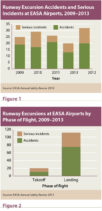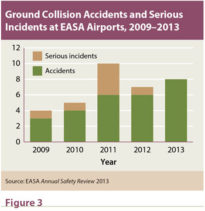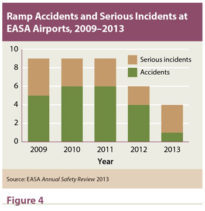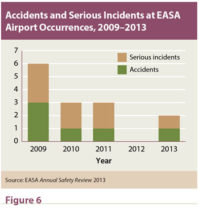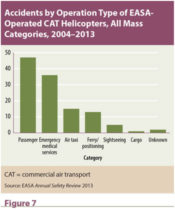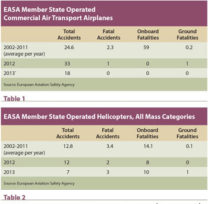The number of runway excursion and ground collision accidents and serious incidents at Europe’s airports increased in 2013 from the previous year, but the number of ramp-related accidents declined, according to the European Aviation Safety Agency’s (EASA’s) recently released Annual Safety Review 2013. Data in the review cover the 28 European Union member states plus Iceland, Liechtenstein, Norway and Switzerland. Airports included in the data are all open to public use, serve commercial transport, provide instrument approach or departure procedures, and have paved runways of 800 m (2,625 ft) or more or exclusively serve helicopters.
EASA airports saw 32 runway excursion accidents and serious incidents last year, which is up from 20 in 2012 and more than in any other year in the past five years (Figure 1). Of 2013’s 32 excursions, 20 were accidents, as defined in International Civil Aviation Organization (ICAO) Annex 13, Aircraft Accident and Incident Investigation, and 12 were categorized as serious incidents, defined as incidents involving circumstances indicating that an accident nearly occurred. The annual number of runway excursion accidents and serious incidents had been on the decline since 2010, when 29 were recorded, up from 25 in 2009. The 20 reported in 2012 were the fewest in the 2009–2013 period.
In the past five years, there have been 132 runway excursion accidents and serious incidents at EASA airports, according to the Annual Safety Review. Of that number, 86 percent occurred during landing and 14 percent during takeoff. The European Aviation Safety Plan (EASp) identifies runway excursions as one of the key operational safety risks for commercial air transport aircraft (Figure 2).
The number of ground collision accidents and serious incidents at EASA airports increased to eight in 2013 from seven in 2012. Ground collisions, which like runway excursions, are identified in the EASp as a key operational safety risk for commercial air transport, are defined as collisions between an aircraft and another aircraft, vehicle, person or object during taxi. In the past five years, there have been 34 ground collision accidents and serious incidents at EASA airports, with 2011 being the worst year, with 10. The best year was 2009, when there were four accidents and serious incidents (Figure 3).
Ramp accidents and serious incidents at EASA airports declined for the second straight year, falling to four in 2013 from six in 2012 (Figure 4). Nine accidents and serious incidents per year were recorded in 2009, 2010 and 2011. Ramp events are those that occur during, or as result of, ground handling operations. Examples include loading, pushback, refueling and deicing errors, EASA said. The most common types of ramp accidents and serious incidents involve collisions with other aircraft, ground objects and with vehicle/equipment operations. Two of 2012’s accidents were fatal. In one, a baggage handler was killed while loading an aircraft, and in the other, the driver of a water truck was killed when the truck collided with the wingtip of an airplane. In total, there have been 37 ramp accidents and serious incidents over the past five years: 22 accidents and 15 serious incidents.
Very few bird strike accidents or serious incidents have been reported at or near EASA airports over the past five years (Figure 5.) Two were reported in 2013, up from one in 2012 and zero in 2011, EASA data show.
Airport accidents and serious incidents, defined as those involving airport design or functionality issues associated with runways, taxiways, ramp areas, parking areas, buildings and structures, fire and rescue services, obstacles on the airport, lighting, markings, signage, procedures, policies and standards, represent another occurrence category tracked by EASA. In the past five years, there were 14 accidents or serious incidents within this category (Figure 6).
Commercial Air Transport
Airplanes of more than 2,250 kg (4,960 lb) maximum takeoff mass (MTOM) from EASA member states involved in commercial air transport (CAT) suffered 18 accidents in 2013, down 45 percent from the 33 in 2012 and down 27 percent from the 10-year (2002–2011) average of 24.6 per year, according to EASA data (Table 1, p. 46). In addition, EASA CAT operators had no fatal accidents last year, and suffered only one in 2012 when a ground operator was killed during baggage loading operations at Rome Fiumicino Airport. There has not been a year with more than one fatal accident involving an EASA member state–operated airplane since 2007. CAT operations involve the transportation of passengers, cargo and mail for remuneration or hire and ferry/positioning flights. Aircraft accidents are aggregated by the state in which aircraft operator is registered.
In the 10-year period 2004–2013, the highest number of fatal accidents (five) were assigned to the loss of control–in flight (LOC-I) occurrence category, as defined by the Commercial Aviation Safety Team–ICAO Common Taxonomy Team. LOC-I involves the momentary or total loss of control of the aircraft by the crew. During the same period, there were four fatal accidents involving fire/smoke post impact (F-POST) and three accidents involving system/component failure–powerplant (SCF-PP). The highest number of nonfatal accidents involved the abnormal runway contact occurrence category, which includes long, fast or hard landings, as well as scraping the tail or wing of the aircraft during takeoff or landing. Ground collisions and turbulence also were among the most common types of nonfatal accidents.
Among helicopters in all mass categories in CAT operations, there were seven accidents involving operators from EASA member states in 2013, of which three were fatal. In 2012, there were 12 helicopter accidents, but only two were fatal, EASA said. Over the 10-year (2002–2011) period, there was an average of 12.8 CAT helicopter accidents per year, of which 3.4 were fatal, resulting in 14.1 onboard fatalities (Table 2).
Passenger operations accounted for more CAT helicopter accidents during 2004–2013 than any other type of operation, followed by emergency medical services (Figure 7). During that same period, offshore operations accounted for 13 percent of fatal accidents and 23 percent of fatalities. According to EASA, offshore operations generally are carried out with large helicopters, which, when an accident occurs, could result in a larger number of casualties. Offshore operations have experienced fewer fatal accidents and fatalities, but the ratio of fatalities to fatal accidents is higher for this type of operation: 7.5 fatalities per fatal accident versus 3.8 fatalities per fatal accident for nonoffshore operations, EASA said.
Broken down by occurrence subcategories, the greatest number fatal accidents were attributed to LOC-I, followed by controlled flight into terrain, low altitude operation and F-POST. The greatest number of total accidents involved LOC-I, followed by system/component failure — non-powerplant, SCF-PP and collision with obstacle(s) during takeoff and landing. SCF-PP includes accidents related to gearbox malfunctions.

